Blue Rubber Bleb Nevus Syndrome
Blue rubber bleb nevus syndrome (BRBNS) is a rare condition that causes numerous arteriovenous malformations in the skin, gastrointestinal (GI) tract and other places in the body.
What You Need to Know
- Blue rubber bleb nevus syndrome is a rare disorder caused by a gene mutation.
- The main symptoms are abnormal, dilated (widened) blood vessels and dome-shaped, blue or purple blister-like blebs on the skin, which may be present at birth. They can develop inside the GI tract and elsewhere in the body.
- The blebs can raise the risk of bleeding, especially when they develop in the GI tract, which can happen in early adulthood.
- Treatment addresses symptoms and the risk of complications such as hemorrhage (severe bleeding).
What is blue rubber bleb nevus syndrome?
Blue rubber bleb nevus syndrome is a rare condition, present at birth and caused by a genetic mutation. The mutation allows abnormally wide, twisted blood vessels to form in the skin, digestive tract and other parts of the body.
The name comes from the way the blood vessel malformations appear. They form dome-shaped, blister-like lesions called blebs, which have a rubbery texture and can appear blue or purple below the surface of the skin or in the lining of the digestive tract. Another name for the disorder is Bean syndrome.
What causes blue rubber bleb nevus syndrome?
The cause is a mutation (genetic change) on a specific gene called TEK or TIE2. The mutation causes chemical signals that allow cells to communicate, leading to formation of new, abnormal blood vessels.
The mutation may happen spontaneously, which means the disease may affect someone without a family history. White people are more likely to have BRBNS than other racial groups. The disease affects females and males equally.
Blue Rubber Bleb Nevus Syndrome Symptoms
The main symptom is blebs, which are lesions that may appear on the skin in babies and children. They can also develop in other parts of the body. Ranging in size from a few millimeters up to 5 centimeters, the blebs have a rubbery texture, and can cause pain when pressed.
A child with blue rubber bleb nevus syndrome may be born with one or more visible blebs. The lesions may grow bigger over the years, and events such as puberty may set off the formation of additional blebs. The blebs can become numerous and may cause pain.
Bleb formations in the lining of the digestive tract may arise in young adults. The small intestine is a common GI location for blebs, but they can also grow in the esophagus (food tube), stomach, liver, spleen or colon.
Blebs in the GI tract can rupture and bleed. Small episodes of bleeding may not be serious, but life-threatening hemorrhages can occur.
In rare cases, blebs can form in other areas:
- Eye
- Heart
- Central nervous system (brain and spinal cord)
- Thyroid or parotid glands in the neck
- Bones
- Muscles
- Lungs
- Bladder
Blue Rubber Bleb Nevus Syndrome Diagnosis
BRBNS may be diagnosed with the following tests:
- Physical examination to look for blebs beneath the skin. A person may have one central bleb that is larger than the others.
- Blood tests and fecal occult blood tests can reveal anemia due to bleeding in the GI tract or another location.
- Ultrasound is a noninvasive and effective way to see blebs inside the body.
- Endoscopic ultrasound uses a tube called an endoscope inserted in the mouth. The technique can help doctors see blebs in the digestive tract.
- MRI may be useful to examine soft tissue in the body and search for blebs.
- Dermoscopy uses a special lighted microscope to examine blebs under the skin.
- Computed tomography (CT) scans, including a special type called CT enterography, may be used to visualize blebs.
- Barium X-rays can help a gastroenterologist see changes in the GI tract due to bleb formation.
- Skin biopsy performed by a dermatologist may be part of the diagnosis.
- Genetic tests can identify signs of gene mutations associated with the syndrome and help confirm the diagnosis.
Blue Rubber Bleb Nevus Syndrome Treatment
Blue rubber bleb nevus syndrome treatment can lessen the impact of symptoms, lower the risk of hemorrhage and improve quality of life.
- Monitoring is an essential part of treating a child or adult with blue rubber bleb nevus syndrome and avoiding complications.
- Blood transfusions, with or without iron supplements, may be necessary if bleeding from blebs results in iron deficiency anemia.
- Sclerotherapy, which uses heat or lasers to seal off blood vessel malformations, may be used to treat blebs on the skin or the soles of the feet if they are painful or disfiguring.
- Surgery may be an option for removing very large blebs. Blebs that are removed do not come back, but more may form elsewhere.
BRBNS may require treatment from multiple specialties
For the best management of symptoms and bleeding risk, people with blue rubber bleb nevus syndrome are likely to be seen regularly by doctors from several different specialties:
- Hematologists are doctors who diagnose and treat blood disease. They can assess and treat a person for anemia if blebs cause internal bleeding.
- Dermatologists treat skin disorders, and may be able to treat blebs in the skin.
- Gastroenterologists identify and treat problems of the esophagus (food tube), stomach, liver, gallbladder and intestines. GI procedures may be recommended to prevent bleeding. Examples would be surgically removing a large bleb from the digestive tract or performing a bypass to remove a part of the intestinal tract that has a large number of blebs.
- Interventional radiologists use imaging-guided techniques to gain access to and treat blood vessel malformations by sealing them off with laser beams or heat.
- An orthopaedic surgeon may be necessary to help manage pain and deformity due to bleb development in the bones.
- Nurse practitioners are nurses who can diagnose and treat health problems, and may be part of primary care.
- If BRBNS affects the heart, a cardiologist may be part of the care team.
- A neurosurgeon can address problems related to blebs growing in the brain, spinal cord or nerves.
Complications of Blue Rubber Bleb Nevus Syndrome
Care for people with BRBNS includes avoiding complications, which can be serious.
Anemia due to blood loss from leaking blebs can require a blood transfusion.
GI hemorrhage is the main danger for people with the disorder. If a large bleb ruptures and bleeds inside the body, the blood loss can be life-threatening.
Blood clots can form due to slower blood flow through tangled or dilated vessels. Redness, heat, swelling and pain can be symptoms of a blood clot.
Intussusception (in-tuh-suh-SEP-shun) of the bowel is another potential complication associated with BRBNS. This term describes a section of the intestine that gets pushed into another, like a collapsing telescope. This is an emergency that may require surgery.
Because of the seriousness of these complications, a child or adult diagnosed with blue rubber bleb nevus syndrome who experiences any abdominal pain or changes in bowel habits should see a doctor right away.
Blue Rubber Bleb Nevus Syndrome Prognosis
It is possible to live a normal lifespan with blue rubber bleb nevus syndrome. Although the venous malformations and blebs will persist, people with BRBNS have options for treatment that can relieve symptoms and lower the risk of complications.
Working with a team of doctors, addressing anemia and avoiding GI hemorrhages can minimize the impact of blue rubber bleb nevus syndrome on both the quality and quantity of life.






